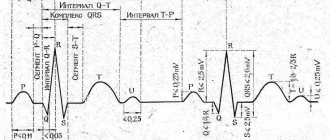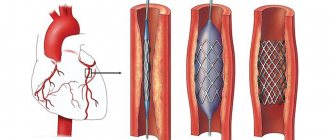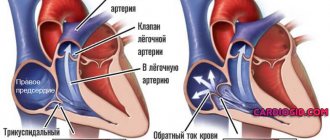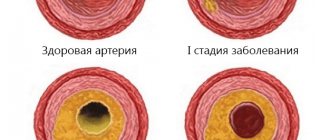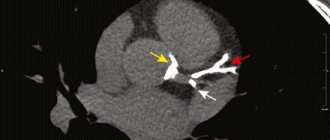Life after stenting
Doctor - cardiologist of the cardiology department (for patients with myocardial infarction) No. 1 Artemyeva A. I.
Coronary stenting is a method of intravascular prosthetics of the heart arteries for various pathological changes in the structure of their wall. Stents are used to reconstruct the corneal arteries.
A stent is a metal frame, which is a small metal tube made of wire cells (Fig. 1). A stent is inserted into the artery after it has widened and is placed at the site of the artery lesion. The stent supports the walls of the artery.
Figure 1 – Stent in a coronary vessel
Stents are placed on balloons, which allows them to have very small dimensions when unexpanded, and after the balloon is inflated inside the coronary artery, they expand, remaining in this position forever. Currently, a variety of stent models are used in interventional cardiology, differing from each other in certain design features. All of them are absolutely compatible with human organs and tissues, have a flexible structure and are elastic enough to support the artery wall. In addition, they are all made from radiopaque materials, which is a prerequisite for subsequent monitoring of their condition.
Recently, in order to prevent restenosis, specialists have begun to actively use drug-eluting stents, from which, after implantation into the coronary vessel, a pharmacological drug is released within several weeks, preventing excessive growth of the intima (inner lining) of the artery and an increase in atherosclerotic plaque. Taking into account modern capabilities, successful results of stenting are observed in 95% of patients who have undergone it. The feasibility of performing this operation and the choice of a specific type of stent is determined by a cardiac surgeon based on diagnostic data obtained during a preliminary examination of the patient.
Stenting can be either planned or emergency. It is carried out under the control of X-ray equipment, under local anesthesia, through a skin puncture on the wrist, forearm or thigh, without the need for large incisions, anesthesia and connection to a heart-lung machine. This intervention does not require strict bed rest and is quite well tolerated by patients.
During the intervention, a stent attached to a balloon catheter is inserted into the artery and advanced directly to the site of narrowing of the vessel. The balloon is then inflated under high pressure and the stent is deployed. The correct installation of the stent is monitored on the monitor screen.
Usually the results of the operation are good, it is relatively safe and the risk of complications after it is minimal. Sometimes an allergic reaction of the body to a substance introduced during the operation for x-ray observation is possible. There is also a hematoma or bleeding at the site of arterial puncture. To prevent complications, the patient remains in the intensive care unit with bed rest. Within a few days, after the wound at the puncture site has healed, the operated patient is discharged from the hospital. After this, restrictions are usually lifted, the person returns to normal life, and observation is carried out periodically by a doctor at his place of residence.
The bloodlessness and apparent simplicity of the operation, the short postoperative period and the effectiveness of coronary stenting make it a modern and popular solution to the problem of many cardiovascular diseases. Unlike surgery, which is performed using artificial blood circulation, the stenting procedure lasts 30-40 minutes and has virtually no complications.
Stenting is not completely effective; in approximately 15-20% of cases the reverse process occurs, and the vessel narrows again. One of the reasons for this process is excessive growth of muscle tissue, and, as a result, narrowing of the vessel wall. However, research by cardiologists does not stop, improving the technology of coronary stenting and achieving increasingly stable positive results statistics.
Currently, about 400 different models of stents have been developed, and the development of the method leads to their constant modernization. These stents differ in the alloy from which they are made, length, shape of the holes, coating of the surface in contact with the blood, and delivery system to the coronary vessels. So, in addition to balloon-expandable stents, there are self-expanding stents, etc.
However, it is worth remembering that even the most advanced methods of cardiac surgery do not replace the need for prevention and careful attention to your health and the health of your heart. Regular physical activity, commensurate with age and physical capabilities, fresh air, a balanced diet, enriched with vitamins and excluding weight gain, limiting the consumption of foods containing cholesterol - these are concepts that never lose their relevance.
The apparent simplicity of stenting, the absence of the need for long recovery after it, as well as the noticeable therapeutic effect of the operation often create in patients the illusion of a complete recovery. However, stenting is aimed only at eliminating the symptoms of the disease. The cause of coronary heart disease - atherosclerosis - continues to exist and progress, creating a threat of recurrence of angina, the development of myocardial infarction, heart failure and other very serious problems.
For this reason, a person who has undergone surgery must be fully aware of all the possible dangers of his situation and the need for further treatment.
Physical activity is one of the most important lifestyle requirements after stenting. Regular exercise slows down the development of atherosclerosis, trains the heart muscle, helps stabilize blood pressure, and has a general health effect on the body. It is important that sport helps the body burn fat, which means maintaining normal weight and blood cholesterol levels.
There are no sets of exercises that would suit every single patient after stenting. The training regimen and intensity are tailored individually, depending on the person’s condition, the list of his diseases, and exercise tolerance. All this is determined by a cardiologist.
The patient who has undergone this operation should be prepared for the fact that from now on he will play sports at least 4-5 times a week. Among specific types of loads, special physical therapy exercises, walking, cycling, swimming, and jogging are recommended. Sports that are accompanied by “explosive” loads, require significant physical effort and potentially pose a risk of injury (weight lifting, boxing) are not recommended.
Speaking about physical activity, it is important to mention sexual activity after stenting. Sexual activity can be carried out as usual; it can be resumed at any time as soon as the patient feels the need for it. On the recommendation of a doctor, you can take nitroglycerin before sexual intercourse, as well as before any other type of exercise. However, this is not always required.
The second extremely important component of therapy is diet.
"Food is medicine." These words are attributed to Hippocrates, and even today we can still attest to their authenticity. Special nutrition after stenting is not just a prevention of heart problems that may or may not arise in the future. This is treatment.
It’s sad, but not all patients adhere to the recommended nutritional rules. And we can say without a doubt that this plays a big role in the high incidence of recurrent angina and repeated stenting.
Diet therapy after stenting of coronary vessels should be based on the following principles.
- restriction in the diet of animal fats. This means reducing the consumption of foods such as fatty meats (lamb, pork), lard, processed foods, margarine. You should not eat butter, cheeses, sour cream, or cream in large quantities. It is also worth limiting your egg consumption to 3-4 eggs per week. All fatty foods are future cholesterol plaques that will resume the symptoms of IHD after stenting.
- limiting refined carbohydrates and sweets. From the foods that are often on your table, you will have to cross out sweets (it is better to replace them with dried fruits), excess sugar, pastries, carbonated drinks, etc. In the body, carbohydrates are converted into fats, which is why you should avoid sweets as much as possible.
- salt restriction. It causes fluid retention and increased blood pressure. Many patients with coronary artery disease who undergo stenting have hypertension. They should pay particular attention to this recommendation. The amount of salt should be reduced to 3-4 g per day (half a teaspoon). Be careful: many prepared foods (canned food, bread, etc.) contain salt, so you should limit its consumption more or less depending on what foods are present in your diet.
- limiting the consumption of coffee and other drinks and products containing caffeine (strong tea, chocolate, cocoa). Caffeine causes vasospasm and increased heart function, which creates increased stress on the cardiovascular system and harms patients with coronary artery disease and stenting. However, it is worth understanding: the diet does not require a complete abstinence from coffee; with controlled blood pressure and the absence of severe symptoms, it can be consumed in small quantities. It is better to choose natural Arabica beans - they have less caffeine than robusta and, especially, than instant coffee.
- adding vegetable oils, fresh vegetables and fruits, fish to the diet (consume at least 2 times a week). All this prevents the development of atherosclerosis. Dietary fiber from plant foods binds and removes cholesterol from the intestines, omega-polyunsaturated fatty acids from fish and vegetable oils reduce the content of harmful lipids (low-density lipoproteins, triglycerides) in the blood and increase the content of beneficial ones (high-density lipoproteins).
If your cardiologist recommends taking medications, you must follow this advice. The volume of drug therapy after surgery will decrease, but it is impossible to completely abandon medications for IHD. Follow the treatment regimen and do not forget: your good health after surgery is largely maintained due to the fact that you follow the therapy regimen.
If any complaints appear or the condition worsens, you should definitely consult a doctor for examination and treatment correction.
After undergoing stenting, it is recommended to quit smoking. Actually, this should be done before the operation, and it is best to never start smoking at all. However, if you have undergone surgery and still smoke, you can be given advice that will definitely help: quit cigarettes immediately!
Some patients console themselves with the thought that two or three cigarettes a day is quite a bit, and there will be no harm from them. This is wrong. Any type of smoking (active or passive) with any number of cigarettes smoked negatively affects the heart and blood vessels. It increases blood pressure, has a cardiotoxic effect, accelerates the progression of atherosclerosis, increases the likelihood of developing arrhythmias and the risk of heart attack. The pleasure derived from smoking is in no way justified by the enormous harm it causes.
Now about alcohol. It is a known fact that dry red wine has a healing effect on the heart. In some places you can even find information that it protects against atherosclerosis and almost causes the resorption of cholesterol plaques in the vessels. Indeed, small amounts of such wine have a beneficial effect on the course of atherosclerosis. However:
- we are talking about small quantities of the drink, no more than 1 glass of wine per day.
- only high-quality, expensive alcohol provides benefits, and not those types of alcohol that can be bought in any supermarket
— the benefits of red wine are not so obvious that it is mandatory to drink it regularly. The notorious cessation of smoking will bring many times greater benefits.
After the stenting operation, the patient will be able to return to normal work. The specific time frame for restoration of working capacity may vary; it depends on the person’s condition (the severity of coronary artery disease, the presence of a recent heart attack, etc.) and his profession. Intellectual workers can start working almost immediately after stenting, and those whose specialty is related to physical activity are allowed to start working later.
The stenting operation eliminates the symptoms of coronary artery disease, the person’s condition improves after it, therefore, it is quite rare to talk about registering disability for patients who have undergone it.
In the event that stenting does not lead to improvement, the patient’s angina returns early, or a heart attack occurs after the operation, assigning a disability group to the person is possible. However, this operation is not performed on people at risk of deterioration and complications, so usually stenting still gives a positive result and contributes to the restoration of a person’s performance, and not its final loss.
When a person’s condition stabilizes after surgery, he is allowed to travel by any means and without restrictions. The main thing is that a person regularly takes medications and follows other doctor’s recommendations. Among all types of recreation, it is better to choose an active one, taking into account your tolerance to physical activity. Patients are most often not contraindicated from visiting baths and saunas, although a more specific opinion on this matter should be given by a cardiologist.
A cardiologist is a doctor who often sees and observes his patients for years. Coronary heart disease is a chronic phenomenon, so this is not surprising.
Sometimes you come across such stories: a person develops hypertension, angina, then suffers a heart attack and undergoes stenting. However, even after this, the “adventures” do not end: periodically the patient is hospitalized with hypertensive crises, after some time his angina pectoris returns, he again undergoes stenting or even coronary bypass surgery... Repeated heart attacks and heart failure are not uncommon phenomena even after repeated operations. As a result, a person feels much worse than he could, and his life expectancy is reduced.
Why does this happen? The reason is not only the insidiousness and danger of the disease, although, undoubtedly, both are fully inherent in coronary heart disease. Most often, an unfavorable outcome of the disease is determined by the fact that a person makes insufficient efforts to improve his condition and prolong his life.
If you have had stent surgery and you are not following all the lifestyle recommendations, it is time to consider changing your attitude towards treatment. All the tips listed above are clear, simple and doable; you just need to follow them, constantly and conscientiously.
After stenting, hemodynamics change in the heart and throughout the body, so the body needs time to adapt to this. In addition, with stenting, a foreign body is actually installed in the coronary vessel. This causes a reaction from the immune system and blood clotting, creating an increased readiness in the body to accelerate the development of coronary atherosclerosis, the formation of blood clots in blood vessels, etc.
The period of hospital treatment is not enough for the body to fully recover, so cardiac rehabilitation is recommended for patients after stenting.
A set of health procedures will consolidate the results of therapy and improve a person’s condition. A special training program will help the patient get used to the new lifestyle.
Preparing for treatment
If your stent surgery is scheduled for the morning, do not eat or drink after midnight (you can take the medicine with a sip of water in the morning). If the procedure takes place in the afternoon, do not eat after 10 am.
Tell your doctor about all the medications you take; about pregnancy; about allergies and sensitivities to medications, local anesthesia, latex, contrast dye, or iodine.
You may have a blood test to determine how long it takes for your blood to clot.
Diagnostic tests should be performed to determine whether renal artery stenting is required in this case. Among these tests:
- Angiography. During this test, a catheter is inserted through the groin into the aorta. The study allows you to see how well blood flows through the renal vessels and detect any other vascular pathology.
- Magnetic resonance angiography. This test is similar to a regular magnetic resonance imaging scan, which uses a large magnet to create images inside the body. In magnetic resonance angiography, contrast dye is injected into the blood to better visualize the vessels.
- Computed tomographic angiography. Uses a series of cross-sectional X-rays to create a three-dimensional image of the inside of the body. In our clinic, this is an indispensable method of accurate diagnostics, allowing us to accurately diagnose the pathology of the renal vessels and determine the indications for stenting.
- Duplex Doppler ultrasonography. This test uses sound waves to measure the size of the narrowed area and the speed of blood flow in the renal arteries.


